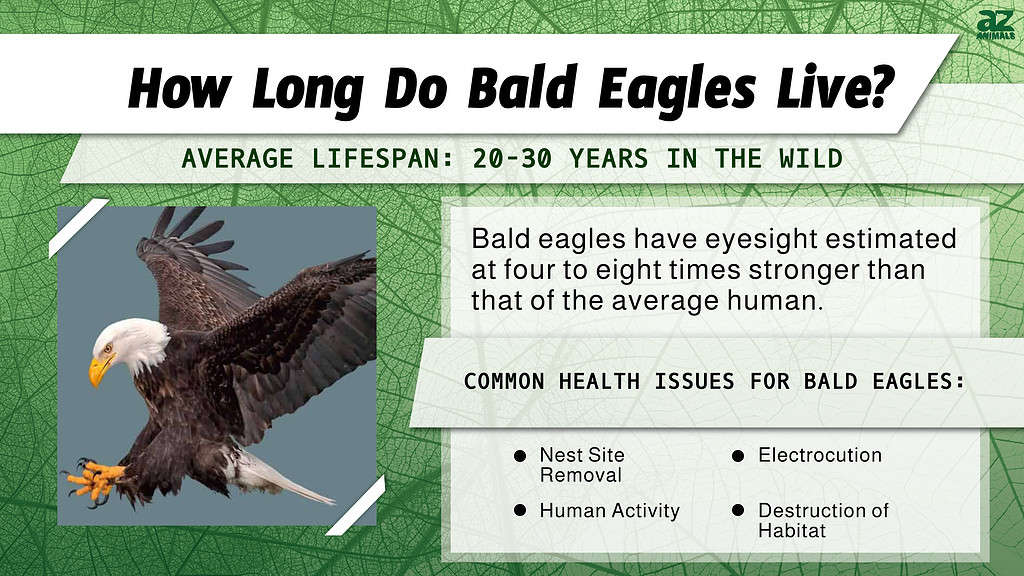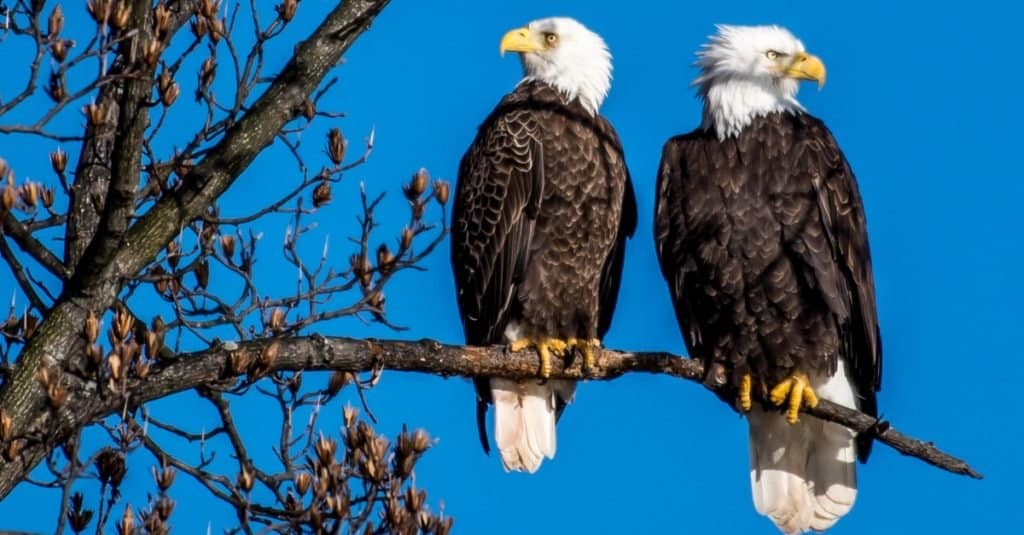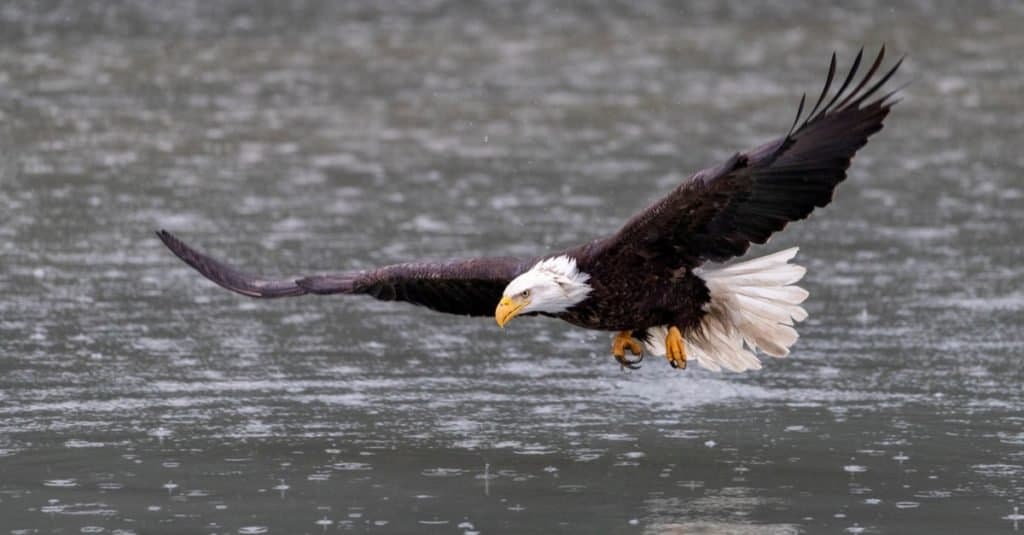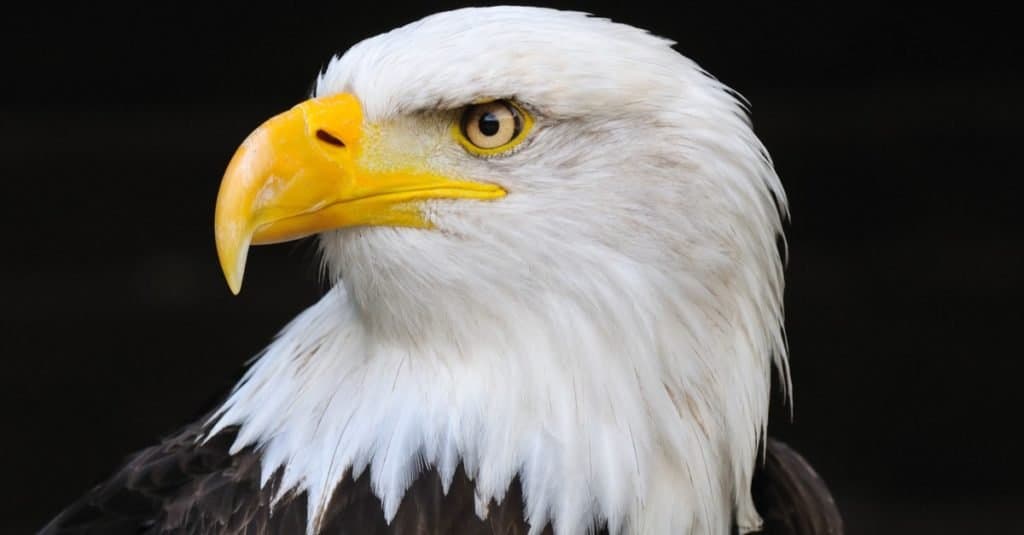
What thoughts immediately spring to your mind when thinking of the bald eagle? Are you instantly thinking of America and the majestic symbolism that the bird has held for the country for so many years? Your first thought may be how big and fierce they are, making them outstanding hunters.
The bald eagle has been a fascinating bird of prey that has captured our attention for many years. Curious to learn more amazing facts about the USA’s national bird? We’ve got the rundown on bald eagles, including the average bald eagle’s lifespan and what factors impact their lives in the wild.
Let’s get ready to learn all about this amazing hunter!
Quick Crash Course on Bald Eagles

Bald eagles can fly at speeds of up to 30 mph and dive at rates of up to 100 mph.
©Krumpelman Photography/Shutterstock.com
Since 1782, the bald eagle has served as the United States national symbol. It was chosen because of its majestic beauty and symbolism of freedom and strength. Long before the bald eagle ever became the emblem of the United States, many indigenous peoples revered the birds and their feathers.
Bald eagles are pretty large birds, and the females are often larger than the males. Female bald eagles reach 43 inches in length, have an eight-foot wingspan, and weigh around 14 pounds. Meanwhile, the males are typically about 25% smaller and weigh a little more than 10 pounds. This is one of the ways you can tell which eagle is the female when looking at a pair.
Bald eagles are opportunistic predators, which means they will steal from other animals in addition to hunting for live food options. They have eyesight estimated at four to eight times stronger than that of the average human. This 20/4 or 20/5 eyesight allows them to notice tiny prey up to two miles away.
Now that we have a better understanding of the bald eagle, let’s find out why the bald eagle’s lifespan is so fascinating!
How Long Do Bald Eagles Live?

The bald eagle is exclusively found in North America, particularly near big inland lakes and rivers with abundant fish.
©Dennis W Donohue/Shutterstock.com
The average bald eagle’s lifespan is 20-30 years in the wild. However, their lifespan in captivity has been reported to be up to 50 years. The oldest confirmed bald eagle in the wild was discovered to be 38 years old when it passed away.
Bald eagles have an unusually long lifespan compared to other birds. This is because they are top predators who don’t have to worry about becoming prey to other animals.
However, the bald eagle’s lifespan comes up short compared to other eagles. On average, other well-known eagle species, such as the harpy eagle, have been estimated to live anywhere between 25-35 years in the wild.
Now that we’ve gotten a better understanding of the bald eagle’s lifespan, let’s take a look at how life begins for this magnificent predator.
The Average Bald Eagle Life Cycle
As such feared and majestic apex predators, it’s fascinating to find out how they turn into their adult versions. Here’s a glimpse of how eaglets develop from shaggy hatchlings to gorgeous adult birds.
Hatchlings
Bald eagles lay between one and three eggs every year, with two being the average. The eggs hatch in the order they were laid. The offspring, called eaglets, are covered in white fluff and are utterly dependent on their parents for nutrition. They are barely three ounces in weight when they hatch. The parents alternate who takes care of the hatchlings. They bring food back to the hatchlings around four times a day on average.
Nestlings
Eaglets stay as nestlings for roughly 10 to 12 weeks before they fledge or leave the nest for the first time. During that time, they develop enough feathers to fly and grow large enough to start hunting independently. The parents will continue to rip apart food and feed it to the nestlings until they can feed themselves. Nestlings can usually start feeding themselves when they are approximately 40 days old.
Fledglings
At 10 to 12 weeks of age, fledglings are usually ready to fledge or take their first flight. They begin by flying to neighboring trees, gradually increasing their distance as they gain confidence in their flying ability. Fledglings return to the nest and stay close to their parents for a month or longer, learning to hunt and refine their flying skills.
Juveniles
Juveniles are eagles in their first year that do not yet have full adult plumage. In their first year, juvenile bald eagles might seem bigger than their parents due to longer flight feathers that help them learn to fly. The wing feathers will be the same size as an adult’s after their first molt.
Adulthood
Bald eagles get closer to the recognizable and characteristic adult feathers with each molt. Most of them have white head and tail feathers between their fourth and fifth years, while some never completely shed the brown pattern. That is usually an indication that the birds have attained sexual maturity and are ready to reproduce.
The Most Common Factors That Impact The Bald Eagle’s Lifespan

By the age of 4-6 years, the bald eagle develops distinctive white head and tail feathers that are easily recognized.
©visuelldesign/Shutterstock.com
Bald eagles are one of the most feared animals in the wild because they are apex predators. However, there are still several factors that shorten their lifespan.
These factors include:
- Natural habitat destruction caused by humans: The degradation of the bald eagle’s native habitat is the most serious threat to the species’ future. The bald eagle population declines as the human population expands. The development of beachfront properties is the most harmful human activity. Because bald eagles rely on waterfront habitats and aquatic food supplies, human development in these prized places is the biggest danger to their existence.
- Nest site removal: Destroying pine trees, which are favored nesting sites, forces bald eagles to use inferior nesting sites. In certain circumstances, there will be no viable nesting sites left in the region. This results in abandonment of the habitat.
- Electrocution: One direct cause of death of bald eagles is electrocution. Power poles are commonly used by bald eagles because they make for good perches.
The photo featured at the top of this post is © Chris Hill/Shutterstock.com
Thank you for reading! Have some feedback for us? Contact the AZ Animals editorial team.







